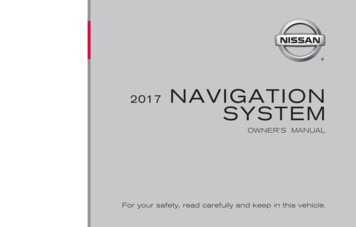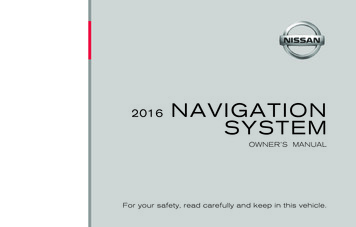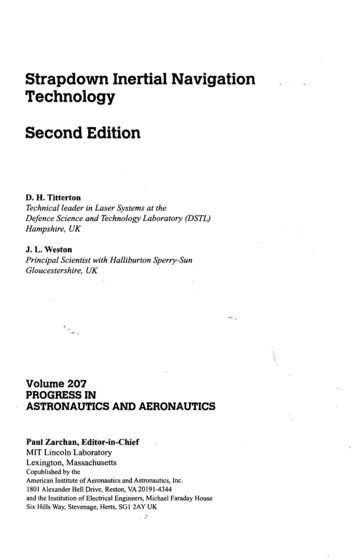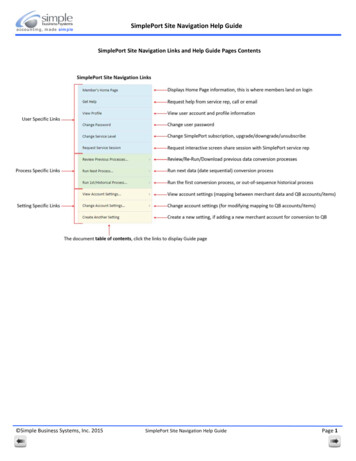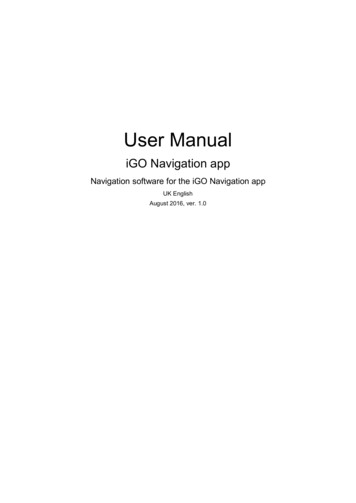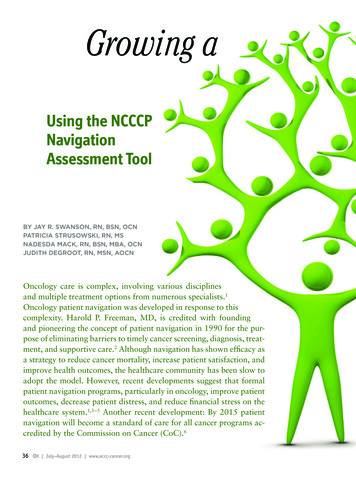
Transcription
Growing aUsing the NCCCPNavigationAssessment ToolBY JAY R. SWANSON, RN, BSN, OCNPATRICIA STRUSOWSKI, RN, MSNADESDA MACK, RN, BSN, MBA, OCNJUDITH DEGROOT, RN, MSN, AOCNOncology care is complex, involving various disciplinesand multiple treatment options from numerous specialists.1Oncology patient navigation was developed in response to thiscomplexity. Harold P. Freeman, MD, is credited with foundingand pioneering the concept of patient navigation in 1990 for the purpose of eliminating barriers to timely cancer screening, diagnosis, treatment, and supportive care.2 Although navigation has shown efficacy asa strategy to reduce cancer mortality, increase patient satisfaction, andimprove health outcomes, the healthcare community has been slow toadopt the model. However, recent developments suggest that formalpatient navigation programs, particularly in oncology, improve patientoutcomes, decrease patient distress, and reduce financial stress on thehealthcare system.1,3–5 Another recent development: By 2015 patientnavigation will become a standard of care for all cancer programs accredited by the Commission on Cancer (CoC).636OI July–August 2012 www.accc-cancer.org
Navigation Programplanning, facilitating, and advocating to meet an individual’shealth needs through communication and available resources,as well as promoting quality cost-effective outcomes. Themain goal of case management is to maintain continuity ofcare through comprehensive, coordinated services, includingthe ability to follow a patient’s changing needs over time. Thisfollow-up is particularly crucial when the patient has a significant and chronic disability.8 Benchmarks for case management require:9 Organizational arrangements to support service delivery Staff trained for the approach and its application to theparticular practice setting A strategy to ensure that the organization can respond toevidence from practice that advocates for systemic andpolicy change.While these definitions and requirements can make it difficult to discern the differences between a navigator and a casemanager, these roles are distinct. Navigator responsibilitiesinclude:10 Conducting comprehensive assessment of a patient’s holistic needs Providing supportive care throughout the continuum ofcancer treatment Connecting patients to individualized information or community resources Facilitating discussions on the management of their cancer.Given these developments, cancer programs that donot yet offer navigation services are beginning to ask:How do we build a cancer navigation program?Current research has focused on explaining navigationwithout discussion of the “how to” aspects of developing anavigation program.7 Thus, a standardized process by whichall navigation programs may assess their developmental progress is needed. While not all navigation programs are createdequal, universal consistencies exist. These “consistencies” canassist cancer centers and navigators in their program development efforts.Navigation vs. Case ManagementCommunity cancer centers in the initial stages of building acancer navigation program should first understand how navigation differs from a case management model of care delivery.Case management is a collaborative process of assessing,The literature identifies three different types of navigators:lay person(s), social worker(s), and nurse(s). A communitycancer center must carefully assess the type of navigatorthat will best meet the needs of its patient population, community, and program. In these challenging economic times,cancer programs do not have the resources for trial anderror, and must have a concise course of action to efficiently build an effective navigation program. The NavigationAssessment Tool discussed below offers a comprehensivepathway for community cancer centers to develop and/orgrow a navigation program.Development of the Navigation Assessment ToolThrough the National Cancer Institute Community CancerCenters Program (NCCCP), navigators from 30 different cancer centers collaborated to delineate core measures to assesswww.accc-cancer.org July–August 2012 O37
USING THE NAVIGATIONASSESSMENT TOOLWhile patient navigators are increasingly common, hospitals have yet to gain consensus on the roles and responsibilities forthe position. To consistently define roles and responsibilities, infrastructure must be standardized. Nationwide, navigationprograms are unique in as many ways as they are similar and must be created to meet the individual needs of a cancer programand its patient population.The NCCCP Navigation Assessment Tool is intended to be used in assessing your navigation program. It is not designed tobe a step-by-step process from one core measure to another. After all core measures are evaluated and levels defined, choosethe core measures your cancer center wishes to improve on and work to increase to a different level within that core measure.To achieve a baseline assessment, we recommend using a multidisciplinary team to ensure the most accurate rating of anew or existing navigation program. The optimal multidisciplinary team would include navigators, administrators, physicians,and any other appropriate healthcare provider connected to oncology patient care. Using the Navigation Assessment Tool,the team should review each category and refer to the definitions to accurately assess a rating—from Level 1 to Level 5—foreach core measure.While an accurate baseline assessment is crucial, determining the proper goal for your navigation program is equally essential. While most programs will seek to be a Level 5, a Level 3 or 4 may be the appropriate course of care based on the needsof the patients, clinicians, and community. Programs are not expected to achieve Level 5 status in all areas, but instead to usethe tool as one way to assess a navigation program and set goals for improvement and growth. In any case, in completing thistool, your program will uncover opportunities for improvement across the continuum. Through this evaluation process, theNavigation Assessment Tool becomes a quality improvement tool, allowing implementation of interventions that can advancea program to the next level. Realistic goals, evaluated annually, will move a navigator program to the most favorable level.progress in developing a cancer navigation program. Thisnetwork of navigators led the effort to establish guidelinesand consistencies in the development of a cancer navigationprogram at NCCCP sites.Recognizing the important role of the nurse navigatorand wanting to support the navigation programs at the 30NCCCP sites, the NCCCP Quality of Care Subcommittee formally established a navigation networking group in 2010. Inmonthly networking conference calls, group members sharedbest practices, tools, job responsibilities, and performance improvement activities. These calls quickly revealed that whilethe 30 NCCCP sites were in different locations, with differentpatient populations, all were encountering the same concernsand barriers in establishing and growing a patient navigation program. To help define a pathway for programmaticadvancement at NCCCP sites, the navigation networkinggroup used a matrix format to develop a Navigation Assessment Tool.The purpose of the Navigation Assessment Tool is to helpcancer programs create a high-quality, patient-focused processthat provides a return on investment (ROI). The tool presentsthe infrastructure and the basic building blocks for starting apatient navigation program. It also provides a framework forcancer programs to set goals and benchmarks and to growtheir navigation services.38OI July–August 2012 www.accc-cancer.orgCore MeasuresAfter a literature review and brainstorming sessions to findcommon themes for the Navigation Assessment Tool, thenavigation networking group identified 16 core measures as“essential” to navigation program development:12345 Key StakeholdersCommunity PartnershipsAcuity System and Risk-factor IdentificationQuality ImprovementMarketing
678910111213141516Percentage of Patients OfferedNavigationContinuum of CareSupport ServicesReporting ToolsFinancial AssessmentFocus on Disparate Population(s)Navigator ResponsibilitiesPatient IdentificationNavigator TrainingEngagement with Clinical TrialsMultidisciplinary ConferenceInvolvementMeasure 1Key StakeholdersBuy-in from the healthcare providers using the navigationservices is critical to the long-term success and survival ofany navigation program.11 The Navigation Assessment Tooldefines the following key stakeholders as essential to a successful program: Navigators and cancer center staff. Cancer center administration. Buy-in from administrationis necessary as navigation is not a direct revenue generatingprogram. Physician involvement (both employed and private practice physicians). Physician support is important, particularly in specialty areas such as medical, surgical, and radiation oncology; rehabilitation; palliative care; and hospice.A key step in implementing a navigation program is to garnerinstitutional support for the program by building consensuswith referring physicians, payers, administration, advocacy,and support networks.12 A program champion is critical andshould be knowledgeable about:13 Healthcare barriers Navigation advocacy Methods to address gaps in services Physician and patient satisfaction Ways to promote the positive impact navigation has forpatients and the healthcare system.In early development (Level 1) community cancer centersgarner support from an administrator committed to cancercenter efforts and activities who can then act as an advocatefor the navigator’s role in meeting both patient and physicianneeds. A highly integrated program (Level 5) is reached whenthe navigation program receives referrals—not only fromoncologists and other specialty physicians—but also fromnon-employed physicians, primary care physicians, and community partners.Each core measure has five levels. These identify program growth potential and allow acancer center to set goals to advance its patient navigation program. Here is a brief lookat each of these core measures.www.accc-cancer.org July–August 2012 OI39
Measure 2Community PartnershipsThe Navigation Assessment Tool defines community partnerships as those entities, within and outside of a program, thatprovide support for patients along the continuum of care.Patient navigators have been described as “supportiveguide(s),” facilitating patient referrals to resources throughout the cancer continuum.14Patients face many medical, emotional, and financial barriers, including:15 Absence of payment sources Insufficient coverage for treatment Lack of affordable transportation and child care Cultural issues Language barriers Limited education.To remove barriers, the oncology patient navigator must beaware of and develop relationships with a cadre of internaland external support services. The Navigation AssessmentTool outlines options from working with departments outsideof the cancer center but still inside your healthcare system(Level 1) to the patient navigator joining a community organization as a committee or board member (Level 5).Measure 3Acuity System and Risk-factor IdentificationMany patient navigation functions are consistent from onenavigator to another—regardless of disease site. However,resources devoted to any particular patient depend on the individual’s needs and the number of patients seen in that particular disease site. Patient needs also vary depending on stageat diagnosis, tumor site, type of treatment (single modalityversus multiple modality), and the extent of the patient’s support system.16 Establishing an acuity system or patient riskfactor system of measurement is necessary to: Assess navigator workload Evaluate navigation assignments based on measured workload (rather than just navigator-to-patient ratios) Provide the support the navigator requires based on acuitylevels.40OI July–August 2012 www.accc-cancer.orgThe Navigation Assessment Tool defines risk factor as thevariable increase of risk from complications with the diseaseand treatment of cancer. Acuity system is defined as the ability to determine the appropriate level of care or interventionbased on patient need and disease process. A Level 1 program is described as having no risk factor or acuity systemavailable—most likely to be true in newly developing navigation programs. Level 5 encompasses an integrated acuitysystem that would ensure quality of care by completing periodic re-evaluation throughout the patient care trajectory withthe goal of addressing issues as they occur and, ideally, preventing issues from occurring. At present, an evidenced-basedacuity system has not been developed or tested for navigation.Hospital- and facility-specific acuity systems and risk assessments are more common in mature navigation programs.Measure 4Quality ImprovementOne of the primary goals of navigation is to overcome barriers to timely and quality care.17 At least four primary measurable outcomes of navigation have been identified within thisarea:181. Improving the time to diagnosis2. Reducing time to initiation of cancer treatment3. Increasing patient satisfaction with care4. Improving cost-effectiveness.As nurse navigation services are not billable, community cancer centers face a growing need to identify measures of sustainability for their navigation programs. Developing qualityimprovement measures will document the worth of navigationby establishing outcomes in a quality improvement format.Under Measure 4, the Navigation Assessment Tool definesa Level 1 program as having no quality improvement measures in place, which may be typical of a newly developednavigation program. Level 2 is achieved through activitiessuch as brainstorming about metrics and reporting findingsto the multidisciplinary team or cancer committee. When atleast one quality improvement initiative is in place, the navigation program moves to Level 3, and so forth until Level5, which requires demonstrated program improvement,quantifiable financial contribution to the cancer program,and identified cost savings to the organization through thenavigation program.
Measure 5MarketingA wide range of disciplines and physicians who champion thenavigation program can help ensure programmatic success.To secure champions and educate both internal and externalcustomers, community cancer centers must effectively markettheir navigation program. Marketing must start at the verybeginning of the navigation implementation process with thegoal of garnering key physician support. Initial marketingmay occur by word of mouth (Level 1). As the program matures, more formal marketing is necessary to increase utilization of navigation services. These marketing initiatives mayinclude basic written materials (Level 2) and health fairs andcancer screening events (Level 3). Level 5 is achieved whenthe navigation program begins using targeted media sourcesto engage internal customers, other healthcare providers, patients, and the community.Measure 6Percentage of Patients Offered NavigationAs mentioned previously, the 2012 American College of Surgeons CoC Standard 3.1 on Patient Navigation states that apatient navigation process is to be established to address barriers to care for patients with cancer and healthcare disparitieseither on site or by referral.6 With Measure 6, the NavigationAssessment Tool provides community cancer centers a meansto monitor the progress being made toward meeting this CoCstandard. One of the challenges in determining the percentageof patients offered navigation is determining the appropriatedenominator, such as all analytical cases or total number ofabnormal breast biopsies.Measure 7Continuum of CareThere are numerous key contact points in the patient navigation journey:12 Abnormal finding to diagnosis Diagnosis to seeing a surgeon Transitions from surgeon to medical oncologist or radiation oncologist Changes in treatment regimens or modalities Transition into survivorship.Focusing on education, logistics, and other support, a patientnavigator can guide the patient through these key contactpoints, coordinate resources, and provide tools for copingwith the high-risk phases, while allowing the physician to focuson the clinical management.7 Thus, community cancer centersshould offer navigation services to patients through, at least,these high-stress phases and into multiple settings (inpatient,outpatient, infusion clinics, radiation departments, etc.).In the Navigation Assessment Tool, the continuum of navigation includes outreach and screening, abnormal finding todiagnosis, treatment, outpatient and/or inpatient care, andsurvivorship and/or end-of-life care. A navigator may haveresponsibility for all areas within the continuum or be designated to cover a specific area. A program may include diseasespecific navigators or have multi-site navigators. The benchmark of a Level 5 program is that navigation is uninterruptedacross the cancer care continuum; all functional areas of thecancer continuum have navigation.In the tool, a program with one functional area within cancer navigation, e.g., a treatment navigator, would score at Level1. As new functional areas, e.g., a survivorship navigator, areadded to the navigation program, higher levels are reachedalong the matrix. Level 5 indicates that navigation occursacross all functional levels of the continuum into survivorship.Measure 8Support ServicesFor patients to be cared for appropriately, community cancercenters should ensure that support for all potential needs isavailable through navigator referrals. Available support thatmay be used by the navigation team can be identified from theinpatient care area (Level 2) or may be accessed through anoutpatient setting (Level 3 or 4). While the focus of a benchmarked program is to have the services available to the patient within the cancer center, established referral patterns tocommunity organizations may be more feasible due to limitedresources. Measure 8 highlights the importance of advocacyto the navigator role, as the navigator is responsible for bothassessing patient needs and making referrals to supportiveservices. To adequately address patient needs, navigatorsmust connect with all members of an interdisciplinary team.www.accc-cancer.org July–August 2012 OI41
Measure 9Reporting ToolsTo evaluate the need for and the success of a navigation program, community cancer centers must develop reporting toolsand/or a means of documenting navigation data.Although electronic patient navigation software systemsare now available, most institutions are reluctant to investlarge sums of money in technology for budding navigationprograms until the Accountable Care Organization (ACO) direction becomes more certain. Paper documentation is a costeffective alternative that allows some flexibility for change asthe navigation program grows.Measure 9, Level 1, is defined as a program that does notoffer a formal navigation report or tool but instead uses thepatient’s chart to describe the navigation services offered tothe patient. To achieve Level 2, the cancer center must develop a simple database (e.g., in Access or Excel) to trackbasic statistics, such as number of patients contacted, diagnosis, and referrals. From these basic steps, hospital information technology (IT) departments can often develop high-levelprogram-specific databases (Level 3). These data can providevaluable reports to assist with evaluation of productivity,timeliness of care, referral patterns, patient satisfaction, andthe overall impact of the navigation program.Integration of these databases into the hospital’s EMR isthe likely next step (Level 4), with the highest level being anelectronic patient navigation system (Level 5). These systemsoffer documentation capabilities, as well as tracking and management tools as patients are navigated through the phases oftreatment; some systems are even able to interface with thefacility via EMR.As a non-revenue producing program, patient navigationprograms must provide robust outcome metrics that can betracked and trended to ensure continued support and resource allocation.Measure 10Financial AssessmentAside from the expected cost of medical care and treatment,patients often struggle with additional costs associated withthe changes to their lives. For example, patients often will decline treatments, drop out of treatment, or delay appropriate42OI July–August 2012 www.accc-cancer.orgfollow-up and possibly jeopardize their outcomes and evensurvival because of the financial burdens of care. Therefore,financial assessment that gauges a patient’s ability to achievethe best possible outcome with the least possible financialburden is a core component of navigation services. Measure10 begins with Level 1: no formal financial assessment performed and progresses to Level 5: a comprehensive financialassessment with data collection completed on types of services provided and number of patients assisted.Most institutions have inpatient financial specialistsavailable to assist patients and families. Now cancer programs are seeing the benefit of using financial specialists tohelp meet the needs of the outpatient population as well.High-priced technology and treatments, complex insuranceplans, and difficult economic times have made the financialspecialist an integral member of the cancer treatment team.Indeed, with such a considerable impact, the financial assessment can be as important as the physical assessment.A proactive approach provides the opportunity to securefunding for diagnosis and treatment, identify serviceswhich may not be covered up front, and provide additionalresources if needed. Addressing and alleviating financialdifficulties helps the patient, as well as the financial viability of the healthcare organization.Measure 11Focus on Disparate Population(s)A key goal of the NCCCP is to provide high-quality cancercare to disparate populations. Americans who live in poverty,as well as certain ethnic and racial groups, have higher cancerdeath rates than other populations.19 Patient navigators are animportant intervention against these disparities.10Measure 11 depicts a cancer program’s journey from identification of the underserved (Level 1) through the outreachto and integration of the defined population (Level 5). Adisparate population can be the Native Americans in Montana, the Pacific Islanders in Hawaii, the rural population ofMaine, the Hispanic population in Pennsylvania, the lowersocio-economic status in Louisiana, or the elderly in Georgia.Each population is different and requires culturally sensitiveprograms and providers to gain trust and meet medical needs.To ensure that staff maintains skills and knowledge, programsshould conduct a cultural sensitivity assessment and createcultural objectives, at least, on an annual basis (Level 5).
Measure 12Measure 14Navigator ResponsibilitiesNavigator TrainingThese are as varied as the institutions in which navigatorswork. Often navigators are initially assigned to a diseasesite-specific patient population, for example breast cancerpatients. Navigators are responsible for the support andeducation of the patient from diagnosis through treatment (Level 1). A more integrated model has the navigator coordinating care between multiple disciplines withinthe cancer program. As the navigation program matures,the navigator’s role may include participation in supportgroups, structured educational offerings, and a variety offamily and patient-centered programs (Level 2). A hallmark of quality care is the offering of disease-specific multidisciplinary clinics or conferences (MDCs), and navigators should attempt to be a part of these patient services(Level 3). Navigators are able to offer insight to the MDCon patients’ physical, emotional, and financial needs andconcerns. Navigators may also be responsible for qualityimprovement projects and assist with medical audits andstrategic planning (Level 5).Whatever the navigator’s level of responsibility, community cancer centers should clearly define the scope of navigator accountability to help focus efforts, as well as to resolveconflict and prevent burnout and avoid unrealistic demandson the navigator’s time, attention, and resources.Staff training is essential to successful implementation of anavigation program. Despite extensive experience in clinicalcare, navigators will require considerable training to excel incore competencies, particularly given the broad array of patient situations likely to be encountered. To ensure effectiveand timely patient interventions, navigators must be trainedto understand the patient experience and know when andhow to engage with the patients.In Measure 14, programs without formal staff training inplace fall within Level 1. To ensure success, however, education on defined core competencies will be necessary (Level2). As experience is gained, programs can develop in-housetraining and curriculum specific to navigator core competencies, allowing continued development of the navigator role(Level 3). This training should eventually become a navigation staff requirement and may be conducted in-house, locally, or through certification in oncology in their respectivedisciplines (Level 4). To achieve Level 5, navigators shouldreceive formal training through a nationally recognized training program.Measure 13Patient IdentificationTo identify patients, the navigator may review pathology reports, daily procedure schedules, or radiology reports sortingpatients by diagnosis (Level 1). Patients may self refer or bereferred by oncology providers who are usually early adaptors, seeing the benefits of care coordination and patient satisfaction (Level 3). As the navigation program develops anddemonstrates improved patient outcomes, primary care physicians and other specialty providers will refer patients appropriately, perhaps at the first indication of a suspicious finding(Level 5).Measure 15Engagement with Clinical TrialsThe navigator plays a key role in educating patients aboutthe benefits of clinical trials and helping patients take anactive role in their own health. Most navigators have basicknowledge of clinical trials; more in-depth education can beobtained through the National Cancer Institute (NCI), theOncology Nursing Society (ONS), or other oncology organizations. Navigators should share this information with patients and the community to dispel misconceptions and fearsurrounding participation in clinical research. Working withthe research team, navigators can identify patients for referral and assist patients in accessing new treatments. At Level5, the navigator is working with the research team, assisting with specific trial referrals for underserved populations.These disparate populations often have limited access to orknowledge of the benefits of clinical trials. It is the navigator’sresponsibility to educate and support the patient and ensureaccess to the highest level of quality care possible.www.accc-cancer.org July–August 2012 OI43
Measure 16Multidisciplinary Conference InvolvementAccording to the CoC, the multidisciplinary conference is integral to improving the care of cancer patients by contributingto the patient management process and outcomes.6 Navigators should attend tumor conferences to: 1) share informationabout the patient care provided through navigation servicesand 2) support the discussion of the patient’s case. With moreexperience and involvement as a member of the MDC team,the navigator will be expected to assist with case finding presentation (Level 3). The navigator can then begin to provideformal review of discussions within the MDC with the patientand family (Level 4), preferably through open communicationbetween the patient and the care team. The most integratedlevel of participation occurs when the patient is informed ofpresentation at the MDC with a full report on the treatmentplanning discussion shared with the patient, referring physician, and the primary care provider (Level 5). At this point, thenavigation program can conduct formal audits, track compliance, and ensure that outcome data are readily available.Future ImplicationsThe Navigation Assessment Tool matrix of program development is both comprehensive and logical. To date, researchefforts have focused on understanding navigation programbenefits for the patient and the facility or clinic. However,without standardization, the efficacy of one program maynot translate to other programs. Therefore, standardizationof process in navigation program development is necessary.5Many new and even established navigation programs areunsure how to grow or remain relevant. With little researchavailable to show strong evidence of navigation programgrowth potential, administrators will begin to question thebenefit from a stagnant program. Through the use of theNavigation Assessment Tool, any program can evaluate itselfagainst 16 core measures that are present in some part forall navigation programs. By having a tool to monitor programmatic growth (and prospects for growth), a navigatoris able to demonstrate expansion opportunities and qualityimprovement of a program through the establishment of realistic goals.—Jay R. Swanson, RN, BSN, OCN, is an oncology nursenavigator at Saint Elizabeth Regional Medical Center in Lincoln, Nebr. Patricia Strusowski, RN, MS, is the clinical director of The Cancer Center at the Helen F. Graham CancerCenter at Christiana Care in Newark, Del. Nadesda Mack,44OI July–August 2012 www.accc-cancer.orgRN, BSN, MBA, OCN, is NCCCP Director at Lehigh Valley Hospital in Allentown, Pa. Judith DeGroot, RN, MSN,AOCN, is lead navigator at Penrose Medical Center in Colorado Springs, Colo.References1. Campbell C, Craig J, Eggert J, Bailey-Dorton C. Implementing and measuring the impact of patient navig
Oncology patient navigation was developed in response to this complexity. Harold P. Freeman, MD, is credited with founding and pioneering the concept of patient navigation in 1990 for the pur-pose of eliminating barriers to timely cancer screening, diagnosis, treat-ment, and supportive care.2 Although navigation has shown efficacyas




